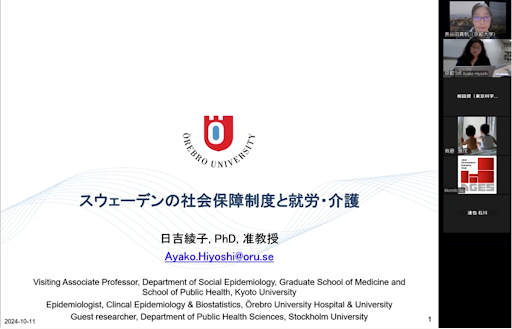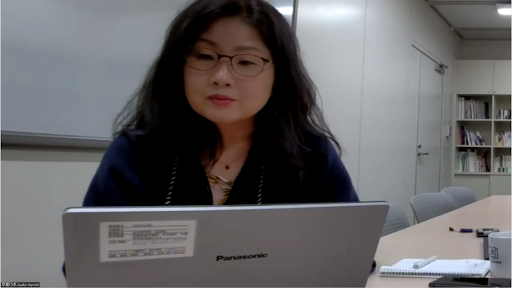Report: Kyoto University School of Public Health International Lecture: Swedish Social Security and Welfare Systems for Adults
In the afternoon of October 11, 2024, an international lecture on “Swedish Social Security and Welfare Systems for Adults” was held at the School of Public Health, Graduate School of Medicine, Kyoto University (KUSPH). About 20 students and faculty members from KUSPH participated in this international lecture, which was held online via ZOOM. Dr. Ayako Hiyoshi, an Associate Professor of Epidemiology, Örebro University Hospital and Örebro University was invited as a guest speaker. She is a Distinguished Visiting Associate Professor of Kyoto University for about 1 month in October 2024. This international lecture aimed to introduce social security and welfare systems for adults in Sweden with contrast to Japan, linking them to different historical background and ideals of the two nations.
After introducing her background, the city of Orebro, and the University Hospital, she provided an overview of the social security and welfare system, comparing it to that in Japan. The most distinctive feature of the social welfare system in Sweden is it is financed through taxes. In terms of healthcare, its tax-based system not only supports the provision affordable care but also the dissemination of nationally vetted information through, for example, the national healthcare web system 1177.se. In her overview, she emphasized that although Swedish system is highly rated globally, it would not be unrealistic to expect the system to be directly applicable to Japan due to differences in historical and social backgrounds. However, in her view, some policies and ideas could still be relevant, inspiring, and beneficial for Japan.
Next, she introduced Swedish social security for workers, the long-term care insurance system, and support for the family members. Regarding social security for workers, she explained that Sweden’s generous parental leave policies and other benefits contributed to a high employment rate for both men and women (approximately 90%). One of the major features of parental leave in Sweden is that parents are entitled to 480 days of leave flexibly used until the child turns 8 years old. They also have the right to limit work, and municipalities are obliged to provide public childcare, including during nights and weekends. In cases of illness, sick leave and other benefits cover all working citizens since taxes fund these programmes, allowing people to use them without hesitation and without affected by job changes. In explaining the security system for working adults, she shared the results of her own research on the use of social security benefits among cancer survivors. Unlike other countries, in Sweden, after cancer diagnosis, the unemployment rate for cancer survivors actually declines compared to non-cancer individuals. Even during the 12 years of observation, there was no difference in the unemployment rate between those with or without cancer. Regarding the long-term care system, she illustrated some background that, although the population aging rate is lower in Sweden than that in Japan, the ratio of long-term care expenditure to GDP is higher in Sweden. The principle of Swedish long-term care is to enable people to live at home as long as possible, with nursing homes considered a last resort due to their higher costs. She noted that home-help services are used by more than twice as many people in Sweden compared to Japan, and nursing homes are instead typically having short residency periods with quick turnover (on average about 2 years). In Sweden, caregiving is considered a societal responsibility, but there is also support for caregivers, with up to 100 days per year of caregiver leave benefits are available not only to family members, but also to neighbors or friends. As a result of such generous social service availability, according to her research that she shared, while the partner’s illness may have an adverse impact, there was little evidence that younger generations are affected by parental illnesses.
Finally, she contrasted welfare state ideals of Sweden and Japan, which have shaped their different social security systems for more than 100 years ago. These systems continue to influence our daily lives – how we work and provide care. She concluded her lecture by quoting Dr. Rose’s words, “The primary determinants of disease are mainly economic and social, and therefore its remedies must also be economic and social. Medicine and politics cannot and should not be kept apart.”
The lecture was followed by a discussion with audience about the role of private sector to maintain services, dental care, databases used for research, care services for young people, requirements for nighttime childcare services, differences in quality between private and public services, and community volunteer activities.

